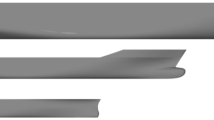Abstract
The hull form optimization concerns one of the most important applications of wave-making resistance theories. In recent years, scholars can determine the hull form by using the optimization method based on the computational fluid dynamics (CFD) and other mathematical techniques. In this paper, the hull form optimization method based on the Rankine source method and nonlinear programming (NLP) is discussed; in the optimization process, a hull form modification function is introduced to represent an improved hull surface and to generate a new smooth hull surface by changing its frame lines and bow stem profiles under the prescribed design constraints. Numerical example is given for a practical container hull form. Finally, shape optimization of bow bulls is shown for non-protruding and protruding bow bulls. This study presents a simplified and practical design method to the select frame lines of bow bulls.
Similar content being viewed by others
References
Zhang Bao-ji. Research on optimization design of hull lines and minimum resistance hull form [D]. Dalian: Department of Naval Architecture, Dalian University of Technology, 2009 (in Chinese).
Kara F, Tang C Q, Vassalos D. Time domain three-dimensional fully nonlinear computations of steady body-wave interaction problem [J]. Ocean Engineering, 2007, 34(5–6): 776–789.
Ma Kun, Ichiro T. A study of optimal hull from for minimum resistance [J]. Journal of Hydrodynamics, 1997, 12(1): 113–122 (in Chinese).
Suzuki K, Ikehata M, Iiiguchi M. Fundamental studies on ship hull form design by means of nonlinear programming (2nd report): Application of low speed theory & experimental verification [J]. Journal of Society of Naval Architects of Japan, 1981, 155: 49–55 (in Japanese).
Hamasaki J, Himeno Y. Hull form optimization by nonlinear programming (part 1): Improvement of prismatic curve for minimizing wave resistance [J]. Journal of Society of Naval Architects of Japan, 1995, 223: 29–34 (in Japanese).
Suzuki K, Iokamori N. Studies on minimization of wave making resistance based on Rankine source method [J]. Journal of Society of Naval Architects of Japan, 1999, 185: 9–19 (in Japanese).
Suzuki K, Kai H, Kashiwabara S. Studies on the optimization of stern hull form based on a potential flow solver [J]. Journal of Marine Science and Technology, 2005, 10(2): 61–69.
Masuda S, Suzuki K. Experimental verification of optimized hull form based on Rankine source method [J]. Journal of Society of Naval Architects of Japan, 2001, 236: 27–32 (in Japanese).
Zhang Bao-ji, Ma Kun. Optimization design of hull lines based on Rankine source method [J]. Journal of Shanghai Jiaotong University, 2010, 44(10): 1414–1417 (in Chinese).
Yoshida T, Suzuki K. Hydrodynamic shape optimization of bow bulbs based on Rankine source method [J]. Journal of Society of Naval Architects of Japan, 2001, 35: 39–47 (in Japanese).
Author information
Authors and Affiliations
Corresponding author
Additional information
Foundation item: the National Natural Science Foundation of China (No. 51009087)
Rights and permissions
About this article
Cite this article
Zhang, Bj. Shape optimization of bow bulbs with minimum wave-making resistance based on Rankine source method. J. Shanghai Jiaotong Univ. (Sci.) 17, 65–69 (2012). https://doi.org/10.1007/s12204-012-1239-3
Received:
Published:
Issue Date:
DOI: https://doi.org/10.1007/s12204-012-1239-3




